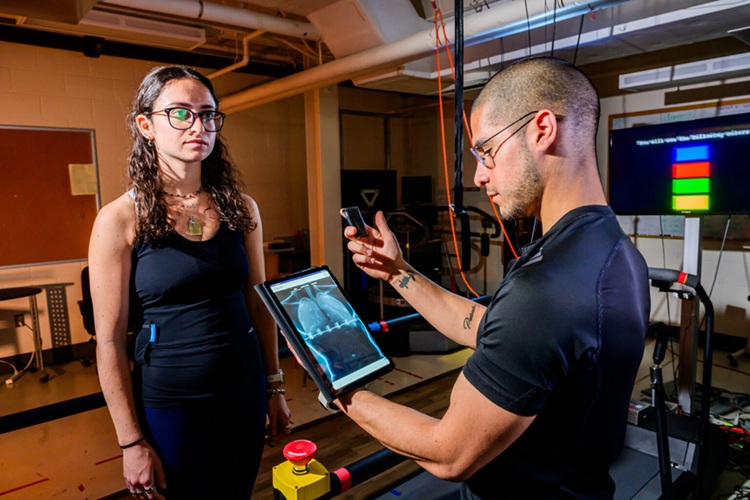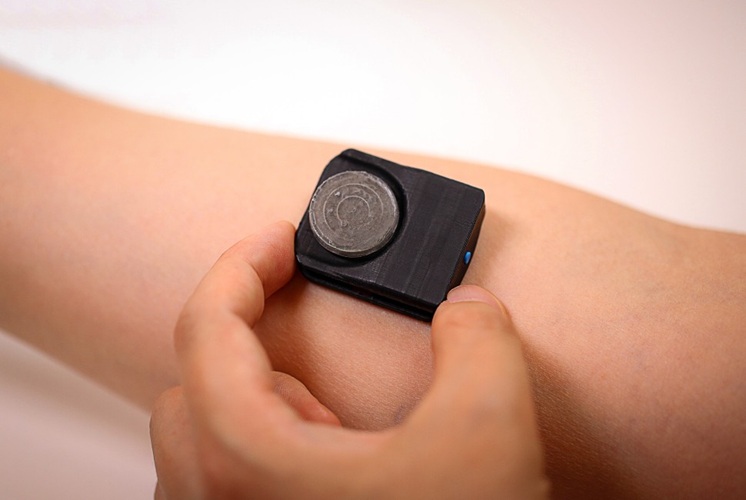Artificial Implant Prosthesis Could Replace Spinal Fusion 
|
By HospiMedica International staff writers Posted on 13 Jan 2014 |

Image: The Total Posterior Solution (TOPS) system (Photo courtesy of Premia Spine).
A novel artificial spinal joint restores function to the posterior spinal column in people suffering from spinal stenosis.
The Total Posterior Solution (TOPS) system is a titanium-sandwiched implant that effectively replaces anatomical structures removed from the vertebrae during the spinal decompression treatment to alleviate pain, such as the lamina or the facet joint. Thus, the boot and internal components of the implant take the place of the supraspinous ligament, interspinous ligament, and ligamentum flavum in their ability to help control flexion. The internal metal stoppers replace the natural bony elements that served as stoppers during axial rotation.
The implant thus allows axial rotation, lateral bending, extension, and flexion, facilitating bending, twisting, and straightening movements at the affected segment of the spine, while blocking excessive posterior and anterior sagittal translation. Once a controlled range of movement is reestablished, patients regain their ability to bend, flex, walk, and enjoy the normal activities of life, while at the same time experiencing immediate and sustained pain relief. The system also protects adjacent levels of the spine from similar degeneration, a common unwanted side effect of fusion surgery.
As with most spinal fusion devices, the TOPS System is anchored to the spine with four standard polyaxial pedicle screws, and is implanted via a traditional posterior surgical approach. The system is intended for adult patients following decompression surgery to alleviate pain stemming from spinal stenosis and/or degenerative spondylolisthesis affecting the L3-L5 lumbar region of the spine, when nonsurgical treatments have failed to provide relief. The TOPS System is a product of Premia Spine (Netanya, Israel), and can be used in conjunction with Premia Spine's Versalink Fixation System to address multilevel diseases of the spine.
“We’ve developed an implant that recreates all functions of the posterior spinal column, where there are important joints, ligaments, and bony structures that provide control over twisting, bending, and flexing,” said Ron Sacher, CEO of Premia Spine. “With the TOPS System, instead of immobilizing we replace the diseased segment with an artificial joint.”
Related Links:
Premia Spine
The Total Posterior Solution (TOPS) system is a titanium-sandwiched implant that effectively replaces anatomical structures removed from the vertebrae during the spinal decompression treatment to alleviate pain, such as the lamina or the facet joint. Thus, the boot and internal components of the implant take the place of the supraspinous ligament, interspinous ligament, and ligamentum flavum in their ability to help control flexion. The internal metal stoppers replace the natural bony elements that served as stoppers during axial rotation.
The implant thus allows axial rotation, lateral bending, extension, and flexion, facilitating bending, twisting, and straightening movements at the affected segment of the spine, while blocking excessive posterior and anterior sagittal translation. Once a controlled range of movement is reestablished, patients regain their ability to bend, flex, walk, and enjoy the normal activities of life, while at the same time experiencing immediate and sustained pain relief. The system also protects adjacent levels of the spine from similar degeneration, a common unwanted side effect of fusion surgery.
As with most spinal fusion devices, the TOPS System is anchored to the spine with four standard polyaxial pedicle screws, and is implanted via a traditional posterior surgical approach. The system is intended for adult patients following decompression surgery to alleviate pain stemming from spinal stenosis and/or degenerative spondylolisthesis affecting the L3-L5 lumbar region of the spine, when nonsurgical treatments have failed to provide relief. The TOPS System is a product of Premia Spine (Netanya, Israel), and can be used in conjunction with Premia Spine's Versalink Fixation System to address multilevel diseases of the spine.
“We’ve developed an implant that recreates all functions of the posterior spinal column, where there are important joints, ligaments, and bony structures that provide control over twisting, bending, and flexing,” said Ron Sacher, CEO of Premia Spine. “With the TOPS System, instead of immobilizing we replace the diseased segment with an artificial joint.”
Related Links:
Premia Spine
Latest Surgical Techniques News
- Intravascular Imaging for Guiding Stent Implantation Ensures Safer Stenting Procedures
- World's First AI Surgical Guidance Platform Allows Surgeons to Measure Success in Real-Time
- AI-Generated Synthetic Scarred Hearts Aid Atrial Fibrillation Treatment
- New Class of Bioadhesives to Connect Human Tissues to Long-Term Medical Implants
- New Transcatheter Valve Found Safe and Effective for Treating Aortic Regurgitation
- Minimally Invasive Valve Repair Reduces Hospitalizations in Severe Tricuspid Regurgitation Patients
- Tiny Robotic Tools Powered by Magnetic Fields to Enable Minimally Invasive Brain Surgery
- Magnetic Tweezers Make Robotic Surgery Safer and More Precise
- AI-Powered Surgical Planning Tool Improves Pre-Op Planning
- Novel Sensing System Restores Missing Sense of Touch in Minimally Invasive Surgery
- Headset-Based AR Navigation System Improves EVD Placement
- Higher Electrode Density Improves Epilepsy Surgery by Pinpointing Where Seizures Begin
- Open-Source Tool Optimizes Placement of Visual Brain Implants
- Easy-To-Apply Gel Could Prevent Formation of Post-Surgical Abdominal Adhesions
- Groundbreaking Leadless Pacemaker to Prevent Invasive Surgeries for Children
- Spectroscopy Technique Improves Surgery for Pediatric Epilepsy Patients
Channels
Critical Care
view channel
Novel Intrabronchial Method Delivers Cell Therapies in Critically Ill Patients on External Lung Support
Until now, administering cell therapies to patients on extracorporeal membrane oxygenation (ECMO)—a life-support system typically used for severe lung failure—has been nearly impossible.... Read more
Generative AI Technology Detects Heart Disease Earlier Than Conventional Methods
Detecting heart dysfunction early using cost-effective and widely accessible tools like electrocardiograms (ECGs) and efficiently directing the right patients for more expensive imaging tests remains a... Read more
Wearable Technology Predicts Cardiovascular Risk by Continuously Monitoring Heart Rate Recovery
The heart's response to physical activity is a vital early indicator of changes in health, particularly in cardiovascular function and mortality. Extensive research has demonstrated a connection between... Read more
Wearable Health Monitoring Device Measures Gases Emitted from and Absorbed by Skin
The skin plays a vital role in protecting our body from external elements. A key component of this protective function is the skin barrier, which consists of tightly woven proteins and fats that help retain... Read morePatient Care
view channel
Portable Biosensor Platform to Reduce Hospital-Acquired Infections
Approximately 4 million patients in the European Union acquire healthcare-associated infections (HAIs) or nosocomial infections each year, with around 37,000 deaths directly resulting from these infections,... Read moreFirst-Of-Its-Kind Portable Germicidal Light Technology Disinfects High-Touch Clinical Surfaces in Seconds
Reducing healthcare-acquired infections (HAIs) remains a pressing issue within global healthcare systems. In the United States alone, 1.7 million patients contract HAIs annually, leading to approximately... Read more
Surgical Capacity Optimization Solution Helps Hospitals Boost OR Utilization
An innovative solution has the capability to transform surgical capacity utilization by targeting the root cause of surgical block time inefficiencies. Fujitsu Limited’s (Tokyo, Japan) Surgical Capacity... Read more
Game-Changing Innovation in Surgical Instrument Sterilization Significantly Improves OR Throughput
A groundbreaking innovation enables hospitals to significantly improve instrument processing time and throughput in operating rooms (ORs) and sterile processing departments. Turbett Surgical, Inc.... Read moreHealth IT
view channel
Printable Molecule-Selective Nanoparticles Enable Mass Production of Wearable Biosensors
The future of medicine is likely to focus on the personalization of healthcare—understanding exactly what an individual requires and delivering the appropriate combination of nutrients, metabolites, and... Read more
Smartwatches Could Detect Congestive Heart Failure
Diagnosing congestive heart failure (CHF) typically requires expensive and time-consuming imaging techniques like echocardiography, also known as cardiac ultrasound. Previously, detecting CHF by analyzing... Read moreBusiness
view channel
Expanded Collaboration to Transform OR Technology Through AI and Automation
The expansion of an existing collaboration between three leading companies aims to develop artificial intelligence (AI)-driven solutions for smart operating rooms with sophisticated monitoring and automation.... Read more















